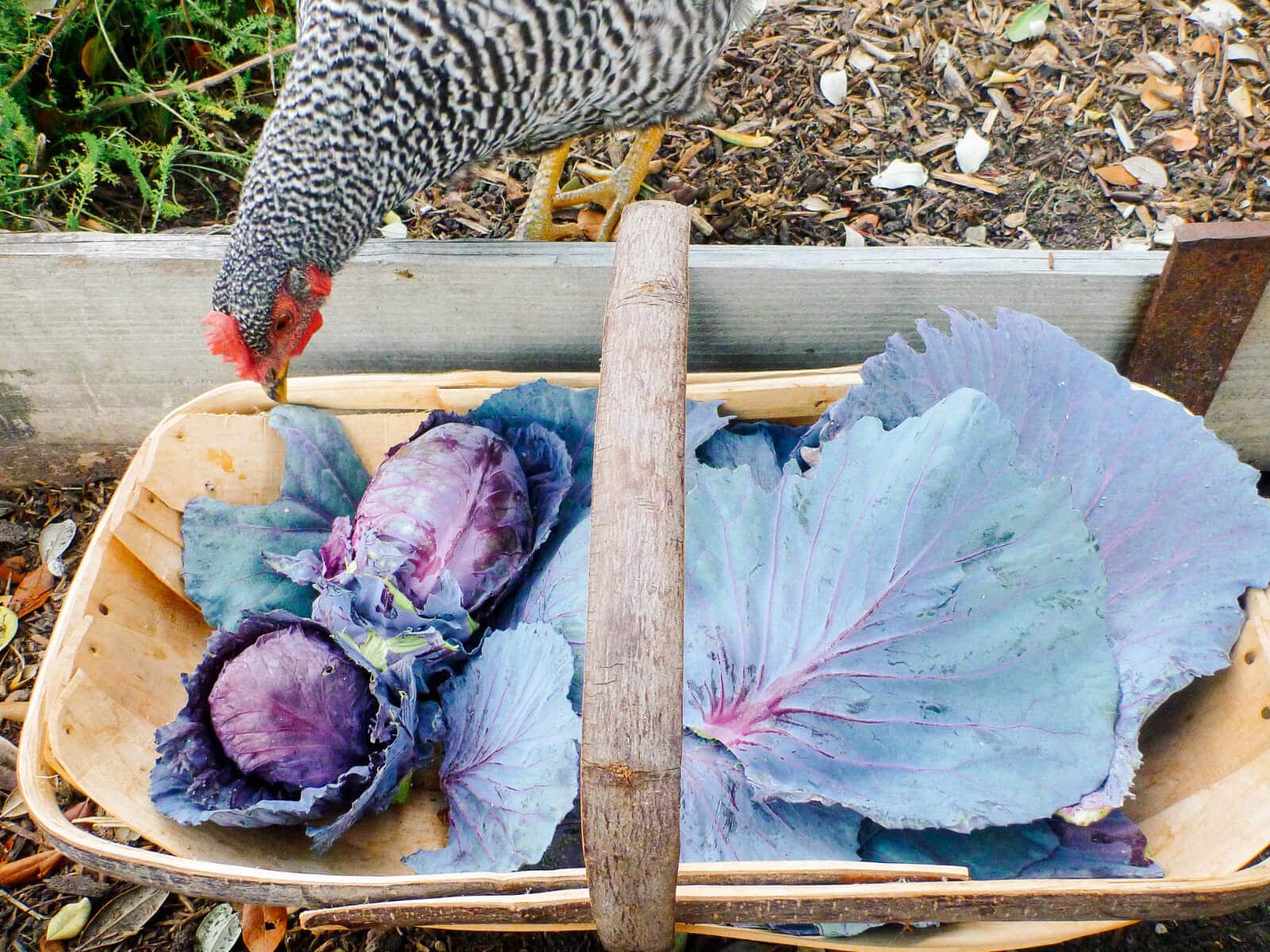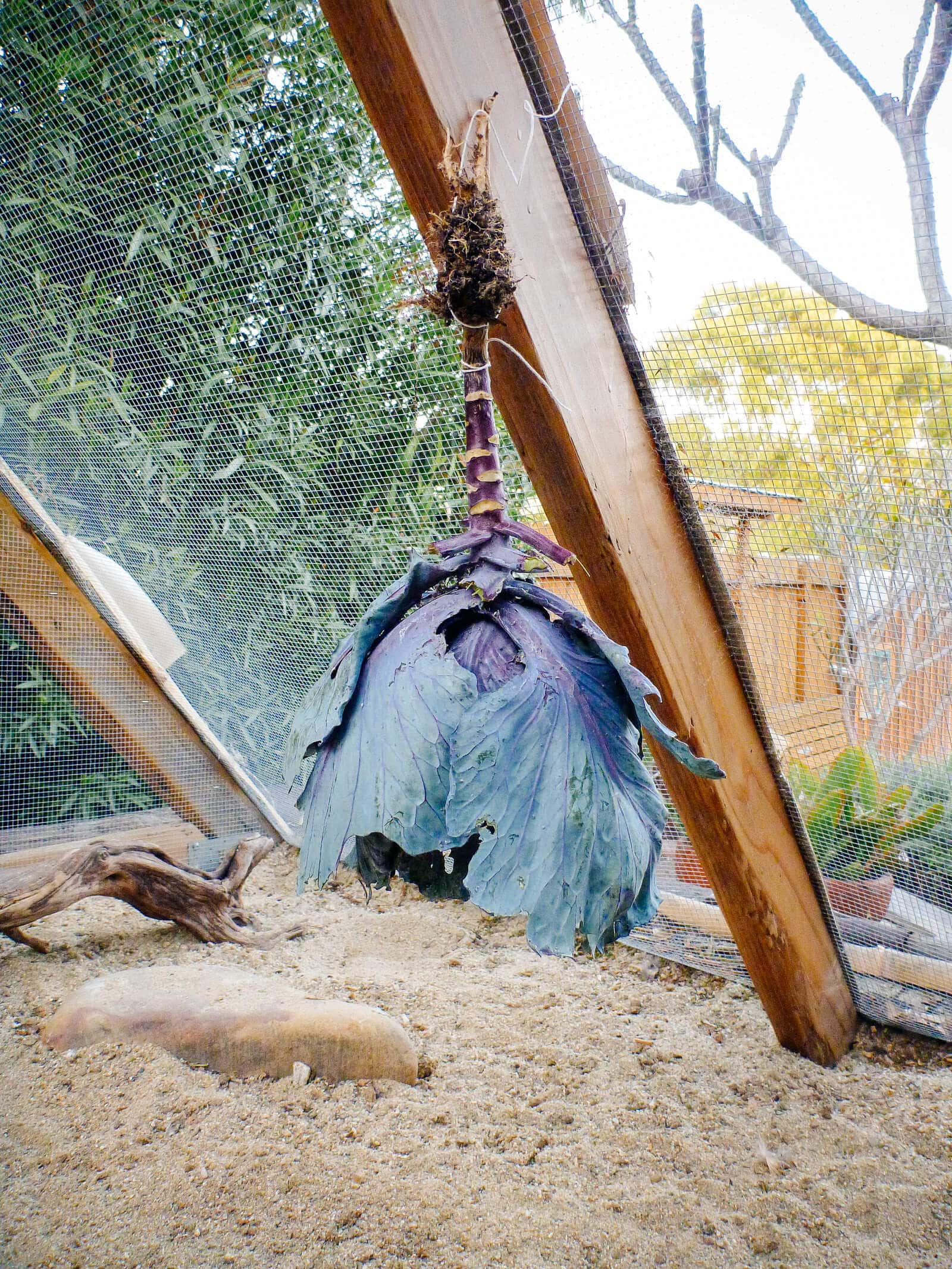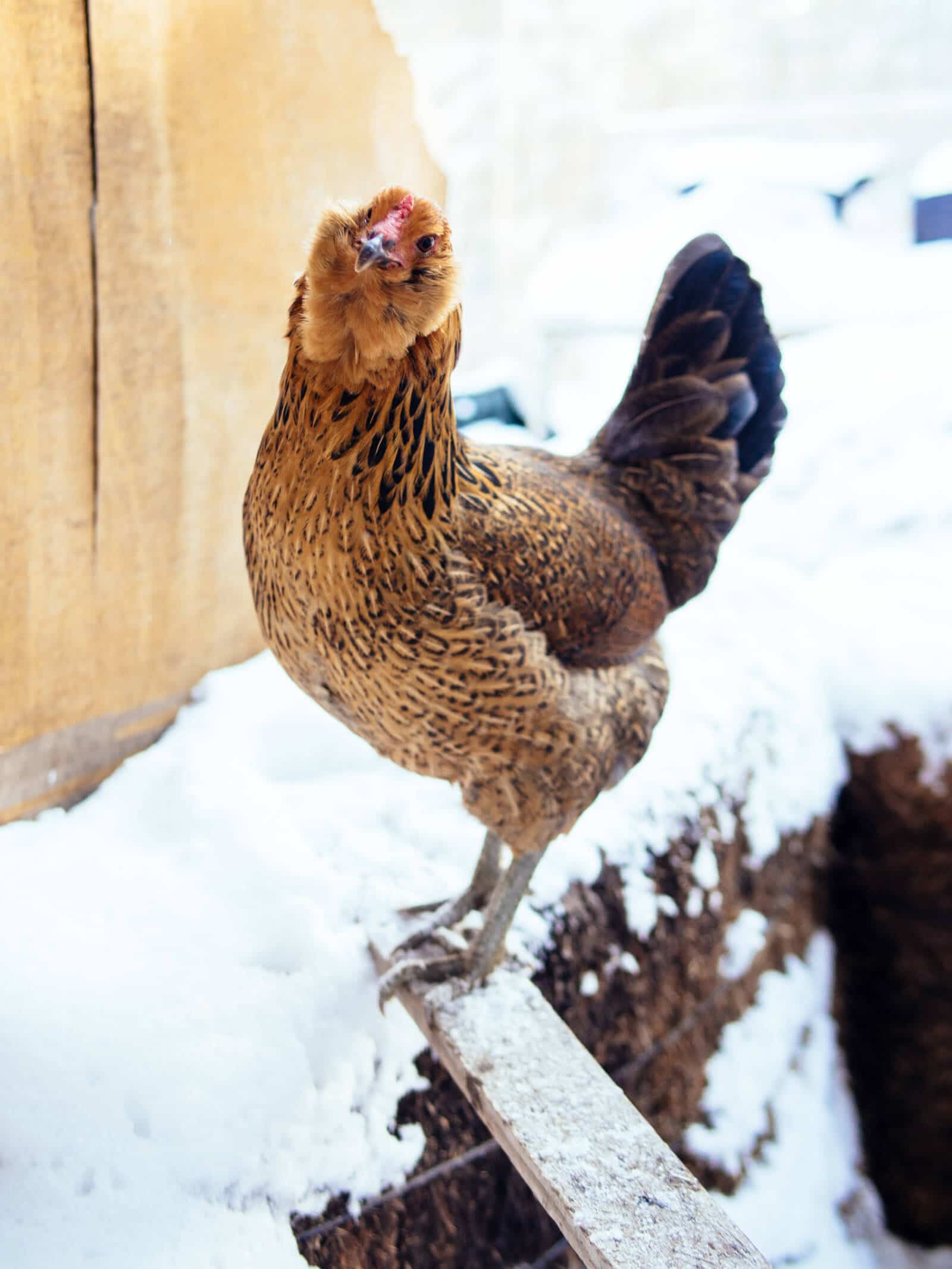It’s the middle of winter. You’re getting very few eggs from your flock, if any at all. They’re still in the stages of seasonal feather loss and feather growth, or they’re just finishing up their last molt.
With their reproductive systems taking a rest and your chickens shedding their coats, winter is an important time for them to rebuild their nutrient reserves and renew their feathers for the year.
Many chickens cease laying during molting as they need to channel all that energy—and all available protein—into growing out their feathers, which are almost purely protein (keratin fiber, to be exact).
Combine that with dormant winter gardens, which leave fewer opportunities for them to forage, and you often need to augment their diet with extra goodies to keep them healthy through the season.
You also don’t want to underestimate the power of playtime: A lazy chicken equals a fat chicken. And a fat chicken equals a sick chicken.
Make sure your chickens don’t end up with coop fever (the feathery equivalent of cabin fever) by giving them something to do and something to eat during the cold weather.

For happy hens, try these seven simple tips for keeping chickens healthy in winter and helping them thrive all season. Come spring, you’ll have a flock that’s fully coiffed and back on track!
Disclosure: If you shop from my article or make a purchase through one of my links, I may receive commissions on some of the products I recommend.

1. Supplement your chickens’ diet with store-bought greens.
Fresh greens in the garden are usually hard to come by in the winter, so you should supplement your chickens’ diet with store-bought salads. (Or strike a deal with your favorite farmers’ market merchant to buy all their leftover greens.)

Choose nutritionally dense, dark greens like kale, collards, chard, and spinach. Try to stay away from the cheap stuff like iceberg lettuce, which is basically just green-tinged water.
Greens (including those lowly weeds) are an important source of vitamins and minerals for chickens, just as they are for humans.

2. Hang a green piñata in the chicken run.
Turn feeding time into a little game for chickens who might be cooped up and restless when it’s grim outside.
I like to hang a head of cabbage inside the run and let the ladies bop it around like a tether ball. By the end of the day, all I’m left with is a half-eaten stalk and a piece of string.

You can also stuff greens into a large suet cage or hanging treat ball and make them work for their food. Keeping them busy and curious is key to preventing bored behavior like egg-eating and feather-pecking.

3. Let grains and seeds sprout naturally in the run.
I discovered this little trick by accident one day!
Many people sprout grains for their chickens to take advantage of all the vitamins and minerals made available. But if you feed your flock a homemade whole grain chicken feed, there are likely quite a few grains flung about in their run which they never get around to eating.

Instead of cleaning up the mess, let Mother Nature do the work: A few days after a rain, all those grains and seeds will sprout themselves—and voilà, instant pasture!

4. Alfalfa is your friend.
If your chickens don’t have access to pasture, up their protein intake by buying a bale of alfalfa for them to scratch.
Alfalfa can be found at your local feed store with the straw and hay bales. Mini alfalfa hay bales and loose alfalfa hay (made for rabbits and other small pets) are available too, if you want to throw a few handfuls inside a small run.
Your chickens will be busy pecking at the alfalfa all winter long, while also getting an excellent fill of protein and fiber.
If you can’t find a mini bale like this and you can’t haul an entire bale home, you can reap the same benefits by adding alfalfa pellets (usually sold as rabbit food) to their regular feed.

5. Bring on the bugs.
Release your chickens right after a rain, as all the moisture in the ground brings out a buffet of protein-filled worms, grubs, and other delectable bugs that they love to scratch, peck, and devour.
If your winter has been dry or your chickens don’t get many opportunities to graze on pasture, toss them a small handful of dried mealworms or dried soldier fly larvae (grubs—my personal favorite since they’re higher in protein and Omega-3s) once a day for their protein fix.
Quick tip: Look for dried mealworms that are marketed for wild bird feeders, which often come in economical bags by the pound. The ones marketed toward chicken-keepers are usually twice the price in much smaller quantities.

6. Cook up a hot, high-protein treat.
I do this often in winter, mainly because my picky chickens sometimes won’t eat dried legumes… but give them a steaming hot bowl of cooked lentils or split peas on a cold dreary day, and they’re all over it!
Legumes offer some of the highest sources of protein (up to 35 percent for lentils) and they’re inexpensive. (Use my chicken feed calculator to research protein levels for some common grains, seeds, and legumes.)
You can also cook up the more expensive—but very protein-rich—grains like kamut and quinoa, and serve them as a special treat.
If I’m feeling generous, I’ll even share my nine-grain oatmeal with the girls: a feast of triticale, rye, wheat, oats, barley, flax, and spelt. (I buy it in bulk from Azure Standard, which is my favorite place to stock up on my chickens’ grains and seeds so I never run out in winter. They’re an online natural foods co-op that carries many ingredients I can’t find locally.)

7. Clear the way for your chickens.
Are your chickens anything like mine? These ladies hate walking in the snow.
If they wake up to several inches of snow on the ground, they huddle together in the coop and refuse to come out, even when I try to tempt them with a steaming hot bowl of oatmeal sprinkled with grubs.
Unfortunately, they have to get out and do what chickens do—peck, scratch, and dust bathe—because extended periods of inactivity and boredom could lead to bad behavior among the flock.
After a decent storm, we try to clear a path through the yard as soon as we can so the chickens aren’t confined to their coop. We also spread wooden planks, plywood scraps, log rounds, and branches (and occasionally, big pieces of cardboard if that’s all we’ve got) throughout the yard for them to perch on and get out of the snow. This lets them get a little exercise and raises morale until they can see the ground again.

If you live in an area that gets snow, make sure to provide a temporary spot where your chickens can dust bathe. (Yep, they still need to do it, even when the ground is frozen tundra.) An easy DIY is to fill a large wash tub with some sand or dirt, and place it in a sheltered area so your chickens have a place to dust bathe out of the rain.
Although winter is coming, these tried-and-true tips will keep your chickens healthy and happy for the rest of the season!
Where to buy chicken feeding supplies
[show_shopthepost_widget id=”3824882″]
Heath Outdoor Products Large Suet Feeder | Ware Manufacturing Chick-N-Veggie Treat Ball | Viking Farmer Fresh Alfalfa Hay | Small Pet Select Alfalfa Hay | Standlee Hay Company Premium Alfalfa Pellets | Chubby Dried Mealworms | Scratch and Peck Feeds Cluckin’ Good Grubs
This post updated from an article that originally appeared on January 25, 2013.
View the Web Story on keeping your chickens healthy in winter.
















Thanks so much for this site. I’ve been raising hens for about 3 years now so I’m still a beginner in many respects. I have 3 hens, Buff Orpington, Plymouth Bard Rock and an Easter Egger. They hatched early April of 2022.
I live in Phoenix, Arizona which is VERY hot in summer.
For some reason, my girls egg production had greatly diminished this year. My Easter Egger still hasn’t started laying again since the winter molt. My other 2 are still laying, but I’m only getting about 4 eggs per week. Last year I was getting 3 per day. I make their feed, which consists of black oil sunflower seeds, whole oats, wheat, barley, flax seeds and hulled millet. I augment their feed with Fertrell’s Nutrifier and Oyster shell calcium. For treats they get dried black soldier fly larva. They also receive kitchen scraps, fresh herb cuttings from my garden as well as all of my grass clippings. From the feed mix alone, according to your feed spreadsheet, they are getting around 17-18% protein.
I have decided to stay away from corn and soy, since they are usually all GMO. I receive all of my feed components from Azure Standard. So they are all organic and of the highest quality. I just can’t figure out why my 2 year old girls aren’t laying very much.
Excessive heat can be stressful to chickens, making them less likely to lay. A possible solution is to offer them more shady spots in the yard (even a patio umbrella works), or perhaps run a sprinkler for them during the hottest part of the day to cool down the run. Or, they might be hiding a clutch of eggs somewhere (perhaps in an area that’s cooler).
Arw you still feeding your chickens lentils? Do you cook them first? If not have you had any issues?
Do you have any suggestions for shell less eggs? I’ve been getting a few this winter. By shelless I mean it has a soft membrane but is missing the hard outer casing. I feed them a similar take on your feed recipe, thanks so much for the feed calculator so handy! Once the weather turned I started fermenting their feed and also occasionally giving them cooked porridge and legumes as well as lots of dark leafy greens. I’m in Ontario Canada and wondered about bit D deficiencies, so I started adding a drop of that as well, but I’m still getting the occasional shelless egg.
That may indicate a calcium deficiency in your hens’ diet. Do you leave oyster shells out for them free-choice? The occasional shell-less egg is nothing to worry about if they’re eating normally, and in winter, it may simply be a sign of their reproductive systems taking a break and/or getting revved up for spring.
It’s very easy to have greens available for them during winter. Sow some winter rye, spelt or wheat in the garden in autumn. It stays alive and green all winter and you can give it to them. In case of snow you can dry some. Excellent source of vitamins! And at the same time it’s green cover crop for the garden which you can utilize in many different ways come spring.
Most of this sounds lovely. Be cautious however of giving cabbage to confined chickens large amounts can sicken them. A small amount is ok and chickens with enough to eat will not gorge on it instinctively.
Cabbage is a healthy treat for chickens, as are other leafy greens. Like any and all foods, they should be given in moderation. No single ingredient should ever be the sole source of your flock’s nutrition.
Lee Wazowski liked this on Facebook.
Kristen Miller liked this on Facebook.
Cristyane Lamastra-Conner liked this on Facebook.
Jun Iguchi liked this on Facebook.
Cleo B. Clark- Chase liked this on Facebook.
Linda,
I too keep my compost heap in the chicken yard, the girls love digging through it & eating all the delicious bugs. I’ve even found them piled together in the middle of it during a blizzard. Silly things didn’t go into their nice protected coop but, sat warming their feet in the hot compost pile .
Luckily I don’t live anywhere near Jay & the chickens not only get the contents of the compost bucket each morning but, also many of our table scraps (talk about acting like it’s Christmas! We also give them any fruit that is about to turn or is beyond smoothie redemption (i.e. Can’t get the husband or kids to drink another one, the freezer is full of almost gone fruit given to us in trade for our organic free-range chicken eggs).
For a while, one of my chickens was actually laying eggs in the compost pile! I guess it really does make a nice makeshift nest, all warm and soft. And I also love how we rarely have to throw out food that’s gone bad, thanks to a flock of hungry hens!
Unfortunately i’m not sure if you are aware but giving chickens anything that has gone via your kitchen is illegal and should not really be promoted. I would also advise against letting hens scratch in compost piles, A: because it will most likely contain kitchen scraps as related to the above comment and B: because compost piles are full of moulds and fungus which can be very harmful to chickens. Sorry if these seem negative comments just want to make everyone aware.
As far as I’m aware, it is not illegal in the United States to give your chickens your kitchen scraps. If you know of legislation somewhere that prohibits this practice, please share the link.
I wonder if you have a different definition of what “kitchen scraps” are, as generally it means the ends of your greens, leftover fruits and vegetables, cold oatmeal, cooked rice, etc. Kitchen scraps are not the same thing as garbage.
Also, it is quite common for chickens to scratch in compost piles – they love it! There are entire (and legal) commercial composting operations built upon chickens pecking and scratching in compost, contributing to the piles with their nutrient-rich poop, turning over the earth and aerating it, etc. Likewise, many backyard chicken-keepers fill their runs with pine shavings and let them transform naturally into compost heaps as the chickens poop, feed on scraps, etc. – this also keeps their coops warm in winter. If you have mold and fungus in your compost (making it smell bad), you might want to reconsider what you’re putting in it and how you’re managing it; a proper compost pile should smell fresh and be full of good microbes that help break it down.
What a weird thing to think. Kitchen scraps are one of the best things to feed your birds! All the odds and ends of vegetables are so good for them! Why would it ever be illegal?!!
From cabbage pinatas for playtime to naturally sprouted grains… Keeping Your Chickens Healthy Through Winter http://t.co/XwLCMU6V9T
Farmmade.com liked this on Facebook.
Cleo B. Clark- Chase liked this on Facebook.
Will you be writing a chicken care book?
LOL… I am far from being a chicken expert at this point! Maybe one day! 😉
We keep a covered winter run full of straw in winter & toss kitchen greens and scratch into it. They love that. I like your cabbage pinata! We grow sun flowers for the hens & save odd ears of corn to hang similarly in the coop to make them jump for it! Fun for them & hilarious for us, too.you have a beautiful flock.
Great idea! If I had different bedding in my run, I’d make a compost pile in the corner. I’ve heard that it gives off heat, and chickens love scratching in it while at the same time fertilizing it!
These are fantastic tips! I’m building up an amazing wealth of information on homesteading from you. 🙂 Thank you!
You’re welcome! Good luck on your homesteading adventures!
Jun Iguchi liked this on Facebook.
Glory Garden liked this on Facebook.
Cristyane Lamastra-Conner liked this on Facebook.
Kristen Miller liked this on Facebook.
Lee Wazowski liked this on Facebook.